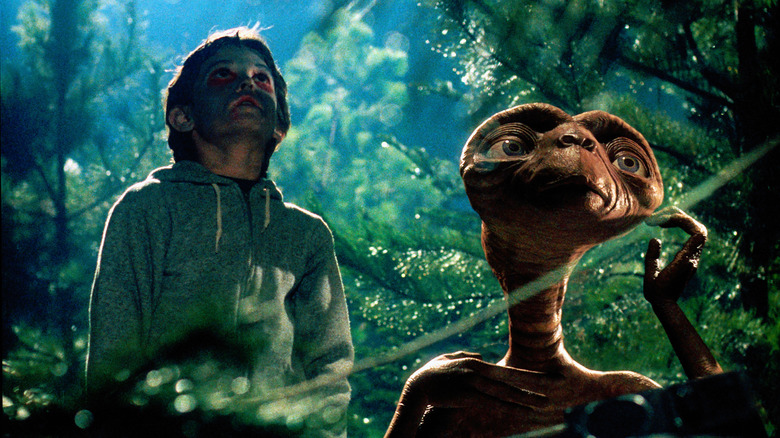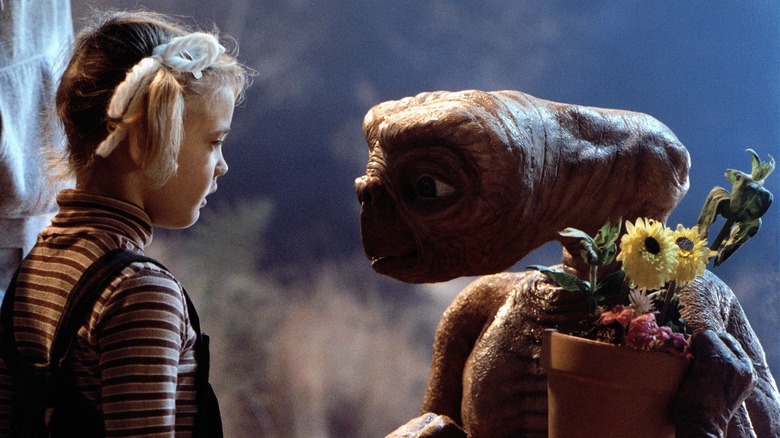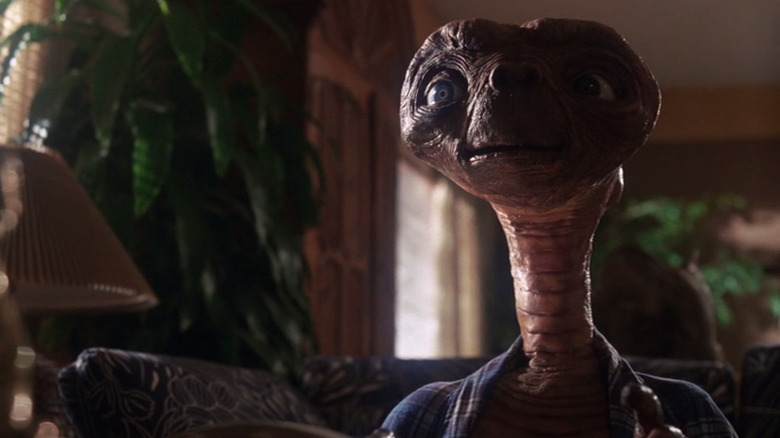Steven Spielberg’s 1983 sci-fi family film “E.T. the Extra-Terrestrial” should have a colon in the title. I know it looks punctuationally “busy,” but “E.T.: The Extra-Terrestrial” simply feels more correct to my typist’s fingers.
Despite this misstep, “E.T.” remains one of the most beloved feature films of the 1980s, and it was so popular that it spawned an entirely new ethos in entertainment. Recall that divorce rates skyrocketed in the late ’70s and early ’80s, and many kids movies began reflecting the change by depicting lonely kids being raised by single parents. While unsupervised, the kids would then find supernatural, extraterrestrial, or otherwise extraordinary adventures just outside their doors. “E.T.” pointed out that kids, when left to their own devices, will discover amazing things … and use their moral wherewithal to take care of them themselves. The kids, “E.T.” declared, are going to be alright.
The story of “E.T.,” for those who don’t know,” follows an unusual, long-necked alien botanist as it is abandoned on Earth. The alien wanders into the backyard of the young Elliott (Henry Thomas), who is terrified at first, but eventually becomes friends with the creature. Elliott, along with his brother and sister (Robert MacNaughton and Drew Barrymore) hide the alien in their house and provide it with Reese’s Pieces as it assembles a machine that would let it contact its home planet. Eventually, E.T. and Elliott become psychically linked, which makes a heartbreaking but ultimately triumphant finale that much more powerful.
“E.T.,” as one might imagine, has been well-reviewed since its initial release, having undergone several re-evaluations, and coming out on top with each one. Pauline Kael called it “a bliss-out,” and Roger Ebert included it on his list of Great Movies. On Rotten Tomatoes, it has a 99% approval rating.
Wait. Only 99%?
The negative reviews of ‘E.T.’
Among the 145 reviews of “E.T.” available on Rotten Tomatoes, only 143 of them were deemed “fresh.” Of those fresh reviews, most of them hover around a 3.5-to-4-star rating, with many feeling that Spielberg’s film is the epitome of movie magic.
There are, however, two negative reviews.
One of them comes from critic Dennis Schwartz, reviewing the film for his own personal ‘blog. He felt the film was “mawkish,” and “crude.” “The film dumbs everything down sitcom style,” Schwartz wrote, “and even reduces the alien mystery to the vulgar lovable relationship between two children from different cultures.” Some might argue that the “children from different culture” was the appeal of the film, but one can see Schwartz’s point; “E.T.” is a simple story wrapped up in sci-fi clothing, reducing the possibilities for alien strangeness and infinite examinations of alien life.
Even harsher was Don McKellar’s review in the Village Voice, published in conjunction with the film’s 20th anniversary re-release. McKellar felt that “E.T.” was no different than a 1950s “Lassie” episode, with a young boy befriending a clever dog and learning to grow up a little as a result. He wrote:
“Of course E.T. is not just a dog. He’s a bit Mary Poppins, a bit Peter Pan. He can move things telekinetically. Communicate telepathically. Heal messianically. Hold off his excretory needs indefinitely. He’s a magic dog! Liberated from the earthly restrictions of the conventional dog, E.T. is free to demonstrate whatever convenient miraculous ability the occasion requires.”
To McKellar’s eye, there’s little logic to E.T. varied superpowers. And he does raise a good point about E.T. not needing to poop. Is his digestive system simply that much more efficient than ours?
But wait, there are more concerns about E.T.
McKellar seems to share Schwartz’s concerns about E.T.’s tendency toward simplicity. Why make the story about a weird alien when similar lessons can already be found on Earth? McKellar continued:
“Despite his ability to learn English in a couple of hours, what does E.T. have to say? The boy learns about tolerance, loyalty, his capacity for love. Well, that’s all fine, but it’s nothing you can’t learn from an Earth dog.”
McKellar was also concerned about the logic of Elliott’s and E.T.’s psychic bond. E.T. gets drunk on beer and somehow that unlocks Elliott’s libido at school, causing him to lay a smooch on a classmate. Was E.T. broadcasting lust into Elliott’s brain? And was that lust inspired by what E.T. was watching on the TV at home? Does E.T. want to boink Earth women?
Some might see these complaints as mere quibbles, missing the fable-like qualities of Spielberg’s film. Yes, it’s a simple boy-and-his-dog story at heart, but the sci-fi wrinkle adds an element of wonderment, of the extraordinary. The fact that E.T. isn’t a cute dog but an unappealing, long-necked lizard/primate makes one’s compassion for the creature all the more striking. “E.T. the Extra-Terrestrial” is Spielberg at his most Spielbergian, tugging on heartstrings and gleefully manipulating audiences to within a micron of their tolerance levels.
Some feel that “E.T.” is so blissfully audience-friendly that it stands outside of criticism, providing a pure cinematic experience unlike any other film. That was the view of Gilbert Adair, writing for Sight & Sound in 2015. For him, “E.T.” is a secular religious experience, an act of cinematic worship. He, too, is right.





